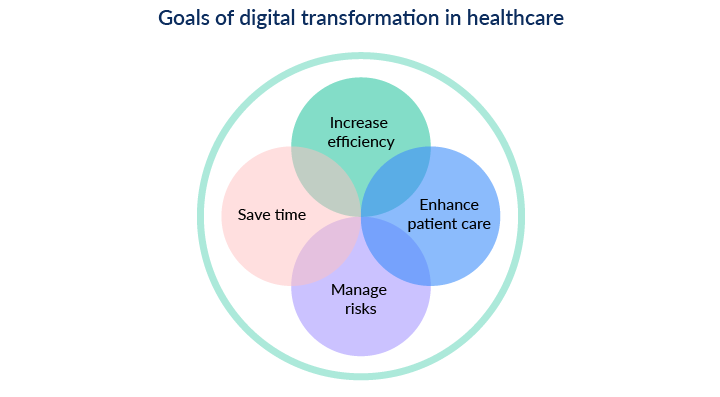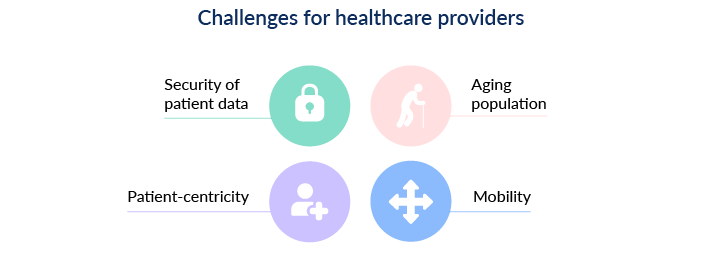60% of organizations today say they have the digital capabilities and 62% say they have the leadership capabilities required for digital transformation – up 24% and 26% from 2018, respectively.
You might be familiar with digital transformation, a process that includes digitalization. And you may already be thinking about introducing new technologies to help your business thrive. However, a lack of guidance on how to carry out digital transformation can lead to doubts and confusion. To convince you to digitally transform your business and to help you get the most out of that process, we’ll share four main steps in the successful digitalization of business processes.
Benefits of digitalizing business processes
Before we dive deep into steps to take your business digital, let’s look at what value digitalization can add to your business.
Data-driven analytics
One key area for digital transformation is data collection. Avoiding paperwork and using modern technology to process data opens new methods of strategic planning. Data analysis helps business owners better understand clients’ needs, find weaknesses in the business, and discover new opportunities.
Process automation
Process automation is an integral part of digitalization. It makes operations more stable, more accurate, and more secure. Following digital transformation guidelines eliminates the risk of losing important documents or missing steps in the transformation process. Process automation reduces manual work and handles repetitive tasks to free your employees time for more sophisticated work.
New market possibilities
The internet gives businesses opportunities to enter new geographic and customer markets, and automation tools helps businesses do that quickly and productively. You can collect data and learn your customers’ behavior to develop a strong marketing campaign. You can also use these tools to attract new customers from social media and raise awareness of your business.
Lower operating costs
Going digital allows you to scale your business and bring in more revenue, while management automation helps you organize employees’ work more efficiently. Technology can also reduce the risk of human errors and allow you to eliminate breakdowns and rework. With computerized analytics, business owners can set more precise goals and monitor progress towards achieving them. Technology helps executives solve problems faster and more efficiently. With the right digital transformation rollout, you would minimize expenses anyway.
How to digitalize business processes
Digital transformation has become a buzzword for a reason. Embracing digital technology is beneficial for any modern business. The main misconception about digital transformation is that arming yourself with modern technologies will be enough to succeed. In fact, digitalization is more profound than it might seem. Let’s take a closer look at what steps you should take to successfully digitalize your business processes.
Step 1. Analyze your business needs
Although digital transformation helps businesses thrive, many business owners don’t take it seriously and focus only on what technologies to implement. They forget about what outcomes digital transformation should deliver.
Nota bene! Instead of deciding what results digital transformation should deliver, business owners focus only on the technology stack.
To avoid a race for trendy technologies, study the needs of your business in detail and find the most promising zones for development. For this, use a data-driven decision-making approach.

Data-driven analytics helps businessmen plan wisely. Trust your gut while developing a business strategy, but verify your decisions with facts. This approach will help do your own thing while being confident about your business results. To develop a business strategy, start with reviewing your business objectives. Which of your goals can you reach using technology? By reviewing your objectives, you might develop some excellent ideas on how to achieve them faster or more efficiently. If you have the data about your customers, previous business results, etc., use it while defining business objectives. Say your aim is to enhance the online client experience. You can find your soft spots based on traffic, conversion, and revenue metrics to see how your customers interact with your website. Keep this information handy when making a decision. Let’s look at some examples of digital transformation goals:
- Automate the payment process
- Enhance data management
- Boost team productivity
- Develop an ecosystem of clients, partners, suppliers, etc.
Step 2. Create a strategy
Since the early 2000s, digital transformation has forced many companies to undergo radical changes. Technological evolution influences the business environment, and companies have to quickly adapt and find new approaches to strategic planning. As a business owner, you need to deeply understand your environment to choose the right business development approach. There are five commonly used approaches you may find helpful for different business environments:
- The classical approach. If your business has a highly predictable environment, you can analyze your starting point, align targets, and develop actions to position your services relative to your competitors and increase your income.
- The adaptive approach. An unpredictable environment requires shorter iterations for examining results and clarifying goals. This approach helps you quickly identify profitable solutions and scale them while stopping investment in useless solutions.
- The visionary approach. To succeed in a predictable and flexible environment, prepare a strong value proposition, get funding, and be ready to scale when your business penetrates the market.
- The shaping approach. An unpredictable and malleable environment forces businesses to engage the whole ecosystem of influencers, from customers to policymakers, to strengthen their competitive advantages.
- The renewal approach. When a business meets disruption and incurs losses, the best executives can do is to conserve resources and find new ways to retain business.
Don’t hesitate to combine approaches to get the best out of each. Your strategy roadmap will depend on what approach you choose. Take a look at these key components of strategic planning to get started with developing your own path to business process digitalization.

Step 3. Reshape the business model
Digitalization of business processes helps you effectively implement your business strategy. But digital transformation isn’t only about minimizing paperwork. Nowadays, people are used to interacting with new technologies and expect to receive a seamless experience while using a product or service. How you deliver value to your customer determines the success of your business.
Pro-tip: To maximize the customer experience, reorganize your business model according to the customer journey.
Try to understand what difficulties the customer may experience at each step of interaction with your service or product. And make sure that new technologies will be accepted by customers. To do this, create prototypes and test them with focus groups.
After you collect feedback from focus groups:
- Go back to your business strategy and see how innovations can improve the customer experience.
- Put together your best ideas about how technology can help your customers get a better experience.
- Describe step-by-step how your customer will use this technology.
This is your customer journey map. You can create several maps to test different scenarios. See what works the best, and get ready to introduce new technologies.
Step 4. Implement your strategy
With a new strategy and business model, you already have ideas for how to achieve your goals. You can now approve technologies, launch a new strategy and test it. Think about the sequence of their implementation, the timing of trials, and the possibilities to scale. You can develop methods for interaction between old and new systems to prevent drastic changes.
Before introducing new technologies, it’s worth determining how the team’s work will be organized during the transformation period. You can assign some of your employees to be responsible for controlling and executing processes, or you can hire a digital transformation specialist. Keep in mind that the transition to automation can be turbulent, and employees may require time to learn and adapt.
It’s good practice to give employees more responsibility to develop a habit of autonomy. A team’s self-dependence drives the end to end delivery of a service or product and allows for an iterative approach to achieving goals.
You’ve already chosen a development path, identified key transformation stages, selected technologies, and assigned responsibilities. Now it’s time to launch the digital transformation of your business. For any company, the period of change is a challenge. But with flexible management, you can react quickly to changes and get good results. Review your goals and track your progress towards achieving them. Always learn modern technologies to know what new tools you can use to improve your business. To convince you to go digital, we’ve prepared examples of successful digital transformations.
Examples of digitalization of business processes
Telemedicine
Healthcare organizations face the same challenges as other businesses when it comes to improving their services through digital transformation. They undergo digital transformation with the key purposes of boosting efficiency, enhancing patient care, minimizing risks, and saving time.

Digital transformation helps healthcare providers meet patient expectations for customer-centric services and reduce expenses. Besides, healthcare providers must adapt to changing cultural and technological requirements.

How do healthcare organizations meet patients demands and successfully implement digitisation of business process on practice? They follow the rule that digital transformation isn’t just about implementing technology. It’s about technology helping them successfully overcome their challenges.
Digital transformation and digitizing business processes in healthcare
| Challenge | Technology | |
|---|---|---|
| Processing, storing, and protecting data | EHR (electronic health records) | |
| Improving the customer experience | Telehealth (telemedicine) | |
| Enhancing mobility | Mobile health | |
| Aging population | Internet of Things technology |
Additionally, by adopting digitization of business processes, healthcare organizations improve their operating models, reduce paperwork, and increase efficiency, as the data is fully transferred to electronic form. There’s still a lot of work to be done. But with the right approach, healthcare providers can quickly adapt to changes and thrive.
Online consulting
Another area that’s rapidly mastering digital transformation is online consulting. Consulting firms and solo consultants are moving their services online to be practical and useful for their clients. Let’s look at the challenges online consultants face and the digital solutions they can use to achieve positive results.
| Challenge | Solution | |
|---|---|---|
| Data digitization and storage | SaaS platforms to manage clients’ data | |
| Improving the customer experience | Tools for seamless communication (video, audio, chat) | |
| Digitization of operating processes | Tools for team management |
When technology can cope with all tasks at once, consultants get more time to improve their service quality. ExpertBox is all-in-one software for video communication with advanced client and team management features. It will help you deliver more consultations by simplifying your management of working hours and optimizing the booking process.
Wrapping up
Digitalization of business processes helps businesses small and large thrive constantly by simplifying processes and providing better customer service. Technology contributes to a company’s internal workflow and service quality. Turning digital requires time and planning, but the results are worth the effort.
Ready to start your digital transformation? See how ExpertBox can help you achieve your goals.
FAQ
-
Although digital transformation helps businesses thrive, many business owners don’t take it seriously and focus only on what technologies to implement. They forget about what outcomes digital transformation should deliver.
-
Going digital allows you to scale your business and receive more income. Management automation helps you organize employees’ work more efficiently. Technology reduces the risk of human errors and allows you to eliminate breakdowns and rework. With computerized analytics, business owners can set more precise goals and monitor their achievements. Technology helps business owners solve problems faster and more efficiently.
-
Common goals of digital transformation include: Automating payment processes Enhancing data management Boosting team productivity Developing an ecosystem of clients, partners, suppliers, etc.



